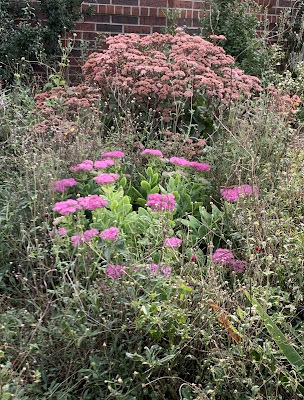So, if you think this blog entry looks messed up, you're correct. Google Blogger made a "new" blog interface and it took me hours to figure out how to wrap text around photos...and it still ain't easy. And I can't figure out now how to just left align the fourth paragraph. I can center it, right align it, and justify it, but can't left align it. Who makes a text editor so bad it won't do that? And now, if you click on a photo to enlarge it, you can't get back to the post by "esc". Google needs to fire its Blogger staff because it probably, based on the feedback I've seen, just ruined this portion of the business. Time will tell if I can stay here or need to start over.
ProfessorRoush surrendered his garden to the fates yesterday. It is time, past time, that cold weather comes in and puts a stop to this madness, the tangles of Knautia macedonia, morning glory vines, and stiff daylily stems, the decaying leaves of summer clinging desperately to the trees, and the creeping crabgrass trying vainly to slip past the gardener. I've grown tired of 2020 and dream of renewal, of the clean slate of snow and the crisp air of winter. My garden remains only in spirit and the color of a few futile sedums, vainly trying to seek the last rays of a dim sun.These sedums, two among many, caught my eye yesterday while mowing, a shorter bright pink foreground Sedum spectabile 'Brilliant' against the backdrop of a taller sedum that I have on my garden map as Sedum telephium 'Arthur Branch'. Although the latter lacks the reddish-leaves characteristic of the variety, I don't doubt its identity; it's the right height and early enough in the season that the red coloration is yet hidden. Both are long-term garden survivors for me, 'Arthur Branch' planted in 2000, the second summer of my garden, and 'Brilliant' in 2001. I already knew, even in those early years on the prairie, that sedums would stand the test of time and carry me into winter, and so they have, each year. I have 8 or 10 varieties that take the flowering place of the fickle fall mums in my garden.



+comp.jpg)
